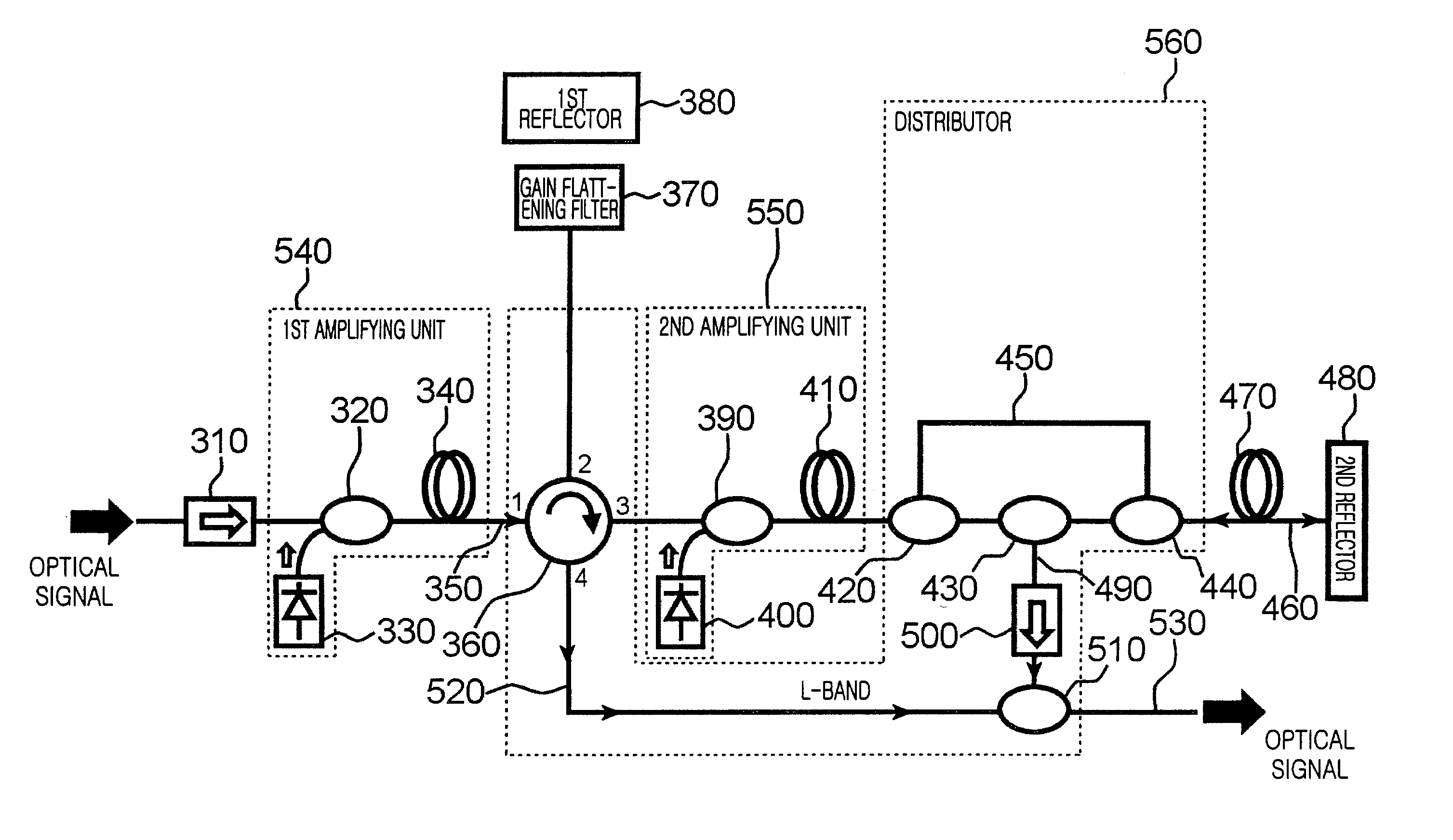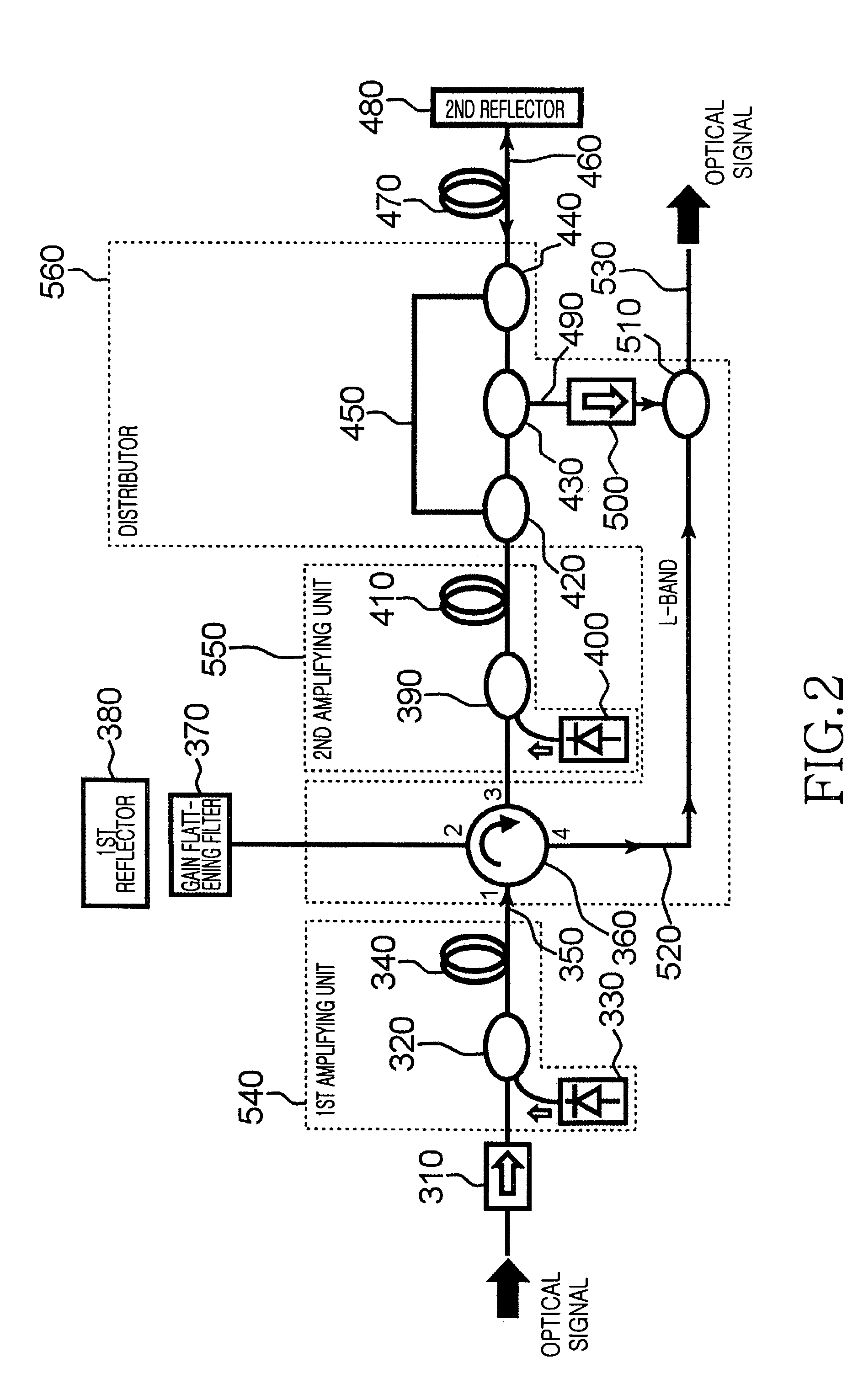Wide band optical fiber amplifier
a wide-band, optical fiber technology, applied in the field of optical communication systems, can solve the problems of limited practical utility of raman amplifiers, insufficient bandwidth to amplify both c and l-bands, and amplifying techniques which have not been thoroughly proven, and achieve low noise, high amplification efficiency, and economic configuration
- Summary
- Abstract
- Description
- Claims
- Application Information
AI Technical Summary
Benefits of technology
Problems solved by technology
Method used
Image
Examples
first embodiment
[0030]FIG. 2 illustrates the configuration of a wide band optical fiber amplifier according to the present invention. As shown in FIG. 2, the wide band optical fiber amplifier includes first and second isolators 310 and 500, first through third amplifying units 540, 550, and 470, a distributor 560, a gain flattening filter 370, and first and second reflecting units 380 and 480.
[0031]The first isolator 310 allows light inputted to the wide band optical fiber amplifier to pass in a forward direction, while preventing (blocking) light from flowing in a backward direction.
[0032]The first amplifying unit 540 includes a first wavelength selective coupler 320, a first pumping light source 330, and a first erbium-doped fiber 340.
[0033]The first wavelength selective coupler 320 couples C and L-band optical signal components received from the first isolator 310 with a pumping light outputted from the first pumping light source 330, and outputs a coupled C and L-band optical signal components ...
second embodiment
[0053
[0054]FIG. 3 illustrates the configuration of a wide band optical fiber amplifier according to a second embodiment of the present invention. As shown in FIG. 3, the wide band optical fiber amplifier includes first and second isolators 610 and 750, first through third amplifying units 785, 660, and 795, a gain flattening filter 650, a distributor 790, and a reflecting unit 740.
[0055]The first isolator 610 allows light inputted to the wide band optical fiber amplifier to pass forward through the wide band optical fiber amplifier, while blocking light flowing in the opposite direction.
[0056]The first amplifying unit 785 includes a first wavelength selective coupler 620, a first pumping light source 630, and a first erbium-doped fiber 640.
[0057]The first wavelength selective coupler 620 couples C and L-band optical signal components received from the first isolator 610 with a pumping light received from the first pumping light source 630, and outputs the coupled C and L-band optica...
third embodiment
[0076
[0077]FIG. 4 illustrates the configuration of a wide band optical fiber amplifier according to a third embodiment of the present invention. As shown in FIG. 4, the wide band optical fiber amplifier includes first and second isolators 810 and 930, first and second amplifying units 985 and 995, a gain flattening filter 940, a distributor 990, and a reflecting unit 920. C and L-band
[0078]In operation, when the C and L-band optical signal components are inputted to the wide band optical fiber amplifier, the C and L-band signals first pass through the first isolator 810, and then the first wavelength selective coupler 820, after which the C and L-band signals enter the first erbium-doped fiber 840. After being amplified in the first erbium-doped fiber 840, the C and L-band optical signal components are applied to the splitter 860. The optical signal applied to the splitter 860 are split into C and L-band optical signal components respectively, whereby the C-band optical signal is ou...
PUM
 Login to View More
Login to View More Abstract
Description
Claims
Application Information
 Login to View More
Login to View More - R&D
- Intellectual Property
- Life Sciences
- Materials
- Tech Scout
- Unparalleled Data Quality
- Higher Quality Content
- 60% Fewer Hallucinations
Browse by: Latest US Patents, China's latest patents, Technical Efficacy Thesaurus, Application Domain, Technology Topic, Popular Technical Reports.
© 2025 PatSnap. All rights reserved.Legal|Privacy policy|Modern Slavery Act Transparency Statement|Sitemap|About US| Contact US: help@patsnap.com



